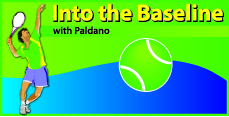Drama on great Grass courts
The best time to see Wimbledon courts in its pristine state, is on the opening day of the Wimbledon Grand Slam. It is a perfect sight, most inviting to play Tennis. It was so this year and one had to be in the main draw of 2014 to enjoy the privilege. The first three days did not shake the seeded players as much as the French-Open, this year. Good players are an attraction to excite the audience. The tournament organizers must be pleased that most of the top players survived the third day.
Russian game
Top ten ranked David Ferrer could not change the game to suit grass and lost. The counter puncher was taken out by the Russian Andrey Kuznetsov world-ranked 118. After losing the second set 0-6 and winning the third in a shaky performance, there was nothing Ferrer could do to stop the slide. The Russian won playing his very effective game.
Those who have followed Tennis would recall Russian, Alex Metreveli who reached the Wimbledon finals in the seventies. The next big Russian name in Tennis after Mikhail Gorbachev’s political reforms was Yevgeny Kafelnikov. I had the opportunity to train a few Russians and to see many of them in performance during their training in Spain. The most significant difference I saw was their swing. While the rest of the world went ‘gung-ho’ for the angular movement which induced acute top-spin, Russians kept their straight arm swings. This eliminated some of the biggest short comings of the top-spin technically in stroke-making and tactically in game-making. It has brought Russia to the forefront of global Tennis. In the last two decades, more than 20 Russian players have held top 20 world-ranking. It includes big names like Marat Safin, Maria Sharapova, Dinara Safina and others. Anna Kournikova while in the rankings added another trend of being a ‘glamour girl’ on the footsteps of Gabriela Sabatini and is a high flyer today. Many Russians have taken after her. In terms of coordination and control, slice the ‘under-spin’ is the easiest to execute but tactically it is limited and defensive. Top-spin is most difficult in coordination, needs more time to execute and can also give too much time to the opponent if not physically built like Rafael Nadal. Flat-shot using traditional straight swing has all the advantages tactically. Russians have mastered this and it is the secret behind Eastern Europe’s success. Technically, flat contact permits to play with mere two grips even to the double handed players. The two grips permit flat, under-spin and the top-spin. Flat needs very little time to execute. The game today is power based, being so, this advantage has an edge in competition. Almost all Russians have straight swing strokes and the appropriate tactic for international competition. Kusnetzsov exhibited this against David Ferrer.
Eugenie Bouchard’s sighting skill
Two Canadians are making their country’s name felt in the early rounds of Wimbledon too. Milos Raonic for the first time has come this far in Wimbledon. The most impressive match so far was Eugenie Bouchard’s win against veteran Slovakian Daniela Hantuchova. Bouchard had to take the game to very high levels to win 7-5, 7-5. She exhibits use of eyes in the best and the most efficient manner. Not only in the return of serve but throughout the rally between shots, she drops the head height with knee and body bends to keep the eyes almost to the level of the net. This coils her body and permits to deliver power with an explosion. Her ability to play well inside the courts and retrieve hard and deep shots of the opponent comes from this advantage. In her match against Hantuchova, Bouchard made her look like a spectator many a times by sending the ball back much faster than expected. Hantuchova did not even have time to initiate a reaction. I have also seen this skill in Serena Williams, at her peak. This is not common. It is a skill specific to some. It almost looks like a scramble but being able to do it all the time, it must be an instilled skill. Tactically on grass and on hard courts, it will pay high dividend.
Exceeding Physical limits
Wimbledon is packed with talent and even the least known players, will thrill the spectators. The simple reason is the road to enter any grand slam is a tightly knit net. To come through this filtering net, players will have to change the way they live, have a level of dedication beyond fascination and glamour; and knowledge to specifics that form their game. Excess training is as bad as insufficient training. Physically sustainable build up, takes many body cycles but the break down can happen in a single cycle. Grass surfaces not being available everywhere, coming to terms with it can push players to the threshold of physical limits. Victoria Azerenka has been struggling to come back since last year. She entered this Wimbledon and another physical break down surfaced.
Having said all this, still there are no big game-makers to challenge the elite of the men’s arena but that is not the case in women. Romanian Halep and Eugenie Bouchard are very impressive and old names Ana Ivanovic, Maria Sharapova and last year’s finalist Sabine Lisicki are still there.
-George Paldano, former international player; Accredited Coach of Germany, ITF and USPTR; National, Davis Cup and Federation Cup Coach–gptennis.ceylon@gmail.com-


